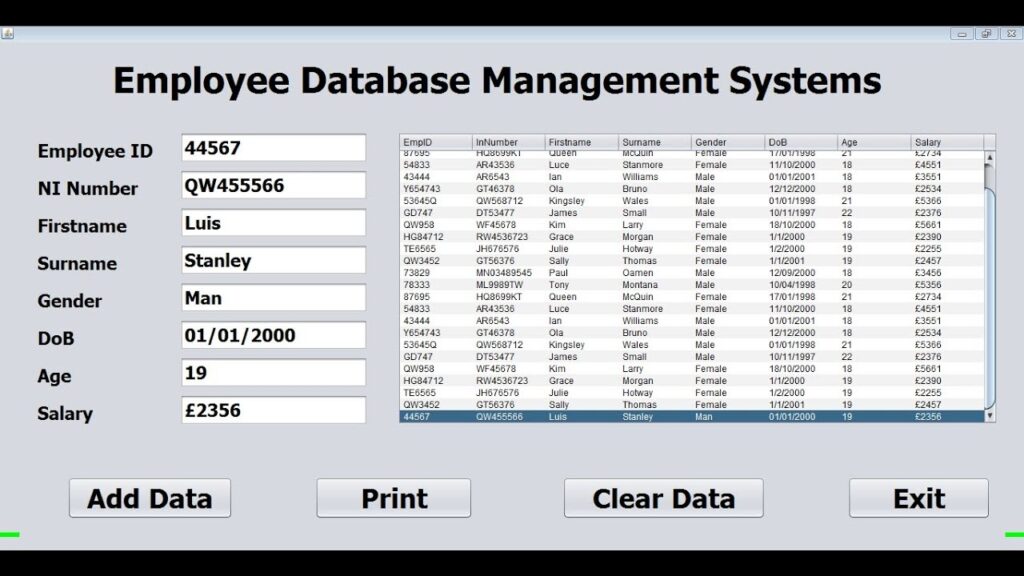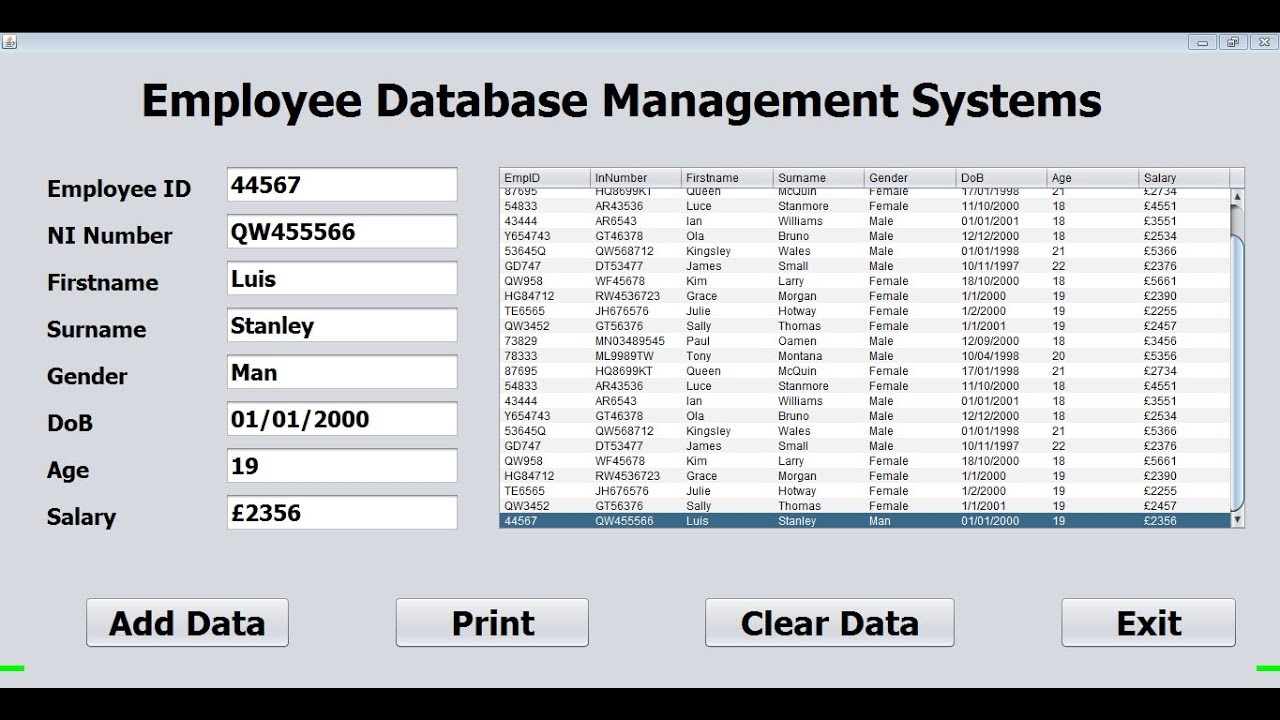
HR Employee Database: Streamlining Human Resources Management
In today’s fast-paced business environment, efficient human resources management is crucial for organizational success. A well-structured HR employee database is no longer a luxury but a necessity for businesses of all sizes. It serves as a central repository for all employee-related information, enabling HR professionals to manage their workforce effectively and make data-driven decisions. This article delves into the importance of an HR employee database, its key features, benefits, and how to choose the right one for your organization. We’ll also explore the challenges associated with implementing and maintaining such a system and offer best practices to overcome them.
What is an HR Employee Database?
An HR employee database is a digital system designed to store and manage employee information. It replaces traditional paper-based records with a centralized, easily accessible electronic system. This database typically contains a wide range of information, including:
- Personal information (name, address, contact details)
- Employment history (start date, job title, department)
- Compensation and benefits information
- Performance reviews and training records
- Attendance and leave records
- Emergency contact information
This data is organized in a structured manner, allowing HR professionals to quickly retrieve and analyze information as needed. Modern HR employee databases often integrate with other HR systems, such as payroll, benefits administration, and talent management platforms, to create a seamless and integrated HR ecosystem.
Key Features of an Effective HR Employee Database
The effectiveness of an HR employee database depends on its features and capabilities. Here are some key features to look for:
Data Security and Privacy
Protecting sensitive employee data is paramount. The database should have robust security measures in place, including encryption, access controls, and regular security audits. Compliance with data privacy regulations, such as GDPR and CCPA, is also essential. [See also: Data Security Best Practices for HR]
User-Friendly Interface
The database should be easy to navigate and use, even for non-technical users. A clean, intuitive interface can improve user adoption and reduce training time. Customizable dashboards and reporting tools can also enhance usability.
Reporting and Analytics
A good HR employee database should offer robust reporting and analytics capabilities. This allows HR professionals to generate reports on various aspects of the workforce, such as employee demographics, turnover rates, and performance metrics. These insights can be used to make informed decisions about HR policies and strategies.
Integration with Other Systems
Seamless integration with other HR systems, such as payroll, benefits administration, and talent management platforms, is crucial for streamlining HR processes. This integration eliminates the need for manual data entry and reduces the risk of errors.
Self-Service Capabilities
Many modern HR employee databases offer self-service capabilities, allowing employees to access and update their own information, request time off, and view pay stubs. This reduces the administrative burden on HR staff and empowers employees to manage their own HR-related tasks.
Scalability
The database should be scalable to accommodate the growing needs of the organization. It should be able to handle increasing amounts of data and support a growing number of users without compromising performance.
Benefits of Implementing an HR Employee Database
Implementing an HR employee database offers numerous benefits to organizations, including:
Improved Efficiency
By centralizing employee information and automating HR processes, an HR employee database can significantly improve efficiency. HR staff can quickly access the information they need, reducing the time spent on manual tasks and paperwork.
Enhanced Accuracy
An HR employee database reduces the risk of errors associated with manual data entry and paper-based records. Automated data validation and consistency checks ensure that employee information is accurate and up-to-date.
Better Decision-Making
With access to comprehensive and accurate employee data, HR professionals can make more informed decisions about HR policies and strategies. Reporting and analytics tools provide insights into workforce trends and performance, enabling data-driven decision-making.
Improved Compliance
An HR employee database can help organizations comply with labor laws and regulations. It provides a centralized repository for tracking employee information and generating reports required for compliance purposes.
Enhanced Employee Engagement
Self-service capabilities empower employees to manage their own HR-related tasks, which can improve employee engagement and satisfaction. Employees can easily access and update their information, request time off, and view pay stubs, reducing the need to contact HR staff for routine tasks.
Reduced Costs
By automating HR processes and reducing the need for manual labor, an HR employee database can help organizations reduce costs. It eliminates the need for paper-based records and reduces the time spent on administrative tasks.
Choosing the Right HR Employee Database
Selecting the right HR employee database is a critical decision that can have a significant impact on the effectiveness of HR management. Here are some factors to consider when choosing an HR employee database:
Business Needs
Identify your organization’s specific HR needs and requirements. Consider the size of your workforce, the complexity of your HR processes, and the types of data you need to track. Choose a database that aligns with your business needs and can support your long-term growth.
Budget
Determine your budget for an HR employee database. Consider the cost of software licenses, implementation, training, and ongoing maintenance. Compare the costs of different options and choose one that fits your budget.
Ease of Use
Choose a database that is easy to use and navigate. A user-friendly interface can improve user adoption and reduce training time. Request a demo of the database and test it out before making a decision.
Integration Capabilities
Ensure that the database can integrate with your existing HR systems, such as payroll, benefits administration, and talent management platforms. Seamless integration can streamline HR processes and reduce the risk of errors. [See also: HR Software Integration Strategies]
Vendor Reputation
Research the vendor’s reputation and track record. Read reviews and testimonials from other customers. Choose a vendor with a proven track record of providing reliable and effective HR employee database solutions.
Security
Security is paramount. The HR employee database must have robust security measures in place, including encryption, access controls, and regular security audits. Compliance with data privacy regulations, such as GDPR and CCPA, is also essential.
Challenges of Implementing and Maintaining an HR Employee Database
Implementing and maintaining an HR employee database can present several challenges, including:
Data Migration
Migrating data from legacy systems to a new HR employee database can be a complex and time-consuming process. Data must be cleaned, validated, and transformed to ensure accuracy and consistency. Plan the data migration carefully and allocate sufficient resources to ensure a smooth transition.
User Adoption
Getting employees to adopt and use the new database can be a challenge. Provide adequate training and support to help employees understand the benefits of the system and how to use it effectively. Communicate the value of the system and address any concerns or resistance.
Data Security
Protecting sensitive employee data is an ongoing challenge. Implement robust security measures, such as encryption, access controls, and regular security audits. Stay up-to-date on the latest security threats and vulnerabilities and take steps to mitigate them.
Maintenance and Updates
Maintaining and updating the database can be time-consuming and require technical expertise. Ensure that you have the resources and expertise to maintain the system and keep it up-to-date with the latest software patches and security updates.
Best Practices for Managing an HR Employee Database
To ensure the success of your HR employee database, follow these best practices:
- Establish clear data governance policies and procedures.
- Regularly audit the database to ensure data accuracy and completeness.
- Provide ongoing training and support to users.
- Implement robust security measures to protect sensitive employee data.
- Keep the database up-to-date with the latest software patches and security updates.
- Regularly back up the database to prevent data loss.
The Future of HR Employee Databases
The future of HR employee databases is likely to be shaped by emerging technologies such as artificial intelligence (AI) and machine learning (ML). These technologies can automate HR processes, improve data analysis, and enhance the employee experience. For example, AI-powered chatbots can answer employee questions and provide personalized support, while ML algorithms can identify patterns in employee data and predict turnover rates.
Cloud-based HR employee databases are also becoming increasingly popular, offering greater flexibility, scalability, and cost-effectiveness. Cloud-based solutions allow organizations to access their data from anywhere, at any time, and reduce the need for on-premises infrastructure.
Conclusion
An HR employee database is an essential tool for modern HR management. It centralizes employee information, automates HR processes, and provides valuable insights into the workforce. By choosing the right database and following best practices for implementation and maintenance, organizations can improve efficiency, enhance accuracy, and make better decisions about HR policies and strategies. As technology continues to evolve, HR employee databases will become even more powerful and essential for managing the workforce of the future.

